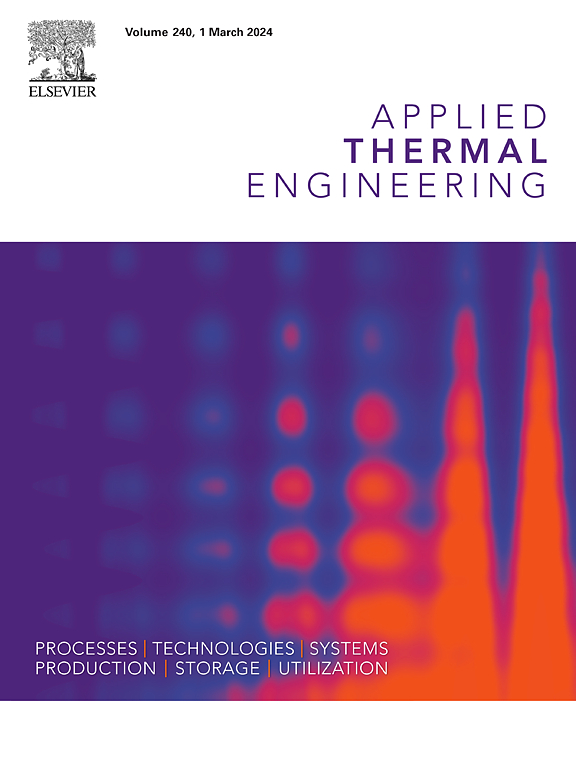Numerical investigation on the performance of a W-type radiant tube using ammonia/hydrogen/methane blends
IF 6.1
2区 工程技术
Q2 ENERGY & FUELS
引用次数: 0
Abstract
As crucial equipment in the metallurgical industry, radiant tubes possess significant CO2 reduction potential. Ammonia/hydrogen/methane blends can mitigate the constraint associated with single-component carbon-free fuel/methane blends, facilitating a higher proportion of methane replacement. Although ammonia/hydrogen/methane blends are promising for the CO2 reduction of radiant tubes, their effect on the performance of radiant tubes remains unclear. In this study, several cases with different NH3/H2/50%CH4 fuel blend ratios are numerically performed to compare the effect of fuel components on the performance of the W-type radiant tube (WRT). Compared to 100 % CH4, using NH3/H2/50%CH4 blends in the WRT could enhance temperature uniformity and reduce CO2 emissions significantly. However, this came with a decreased thermal efficiency and dramatically increased NOx emissions. As the NH3 proportion in NH3/H2/50%CH4 blends decreased from 50 % to 25 %, H2 increased from 0 % to 25 %, the temperature difference increased from 76.2 K to 81.4 K, the non-uniformity coefficient increased from 0.0555 to 0.0591, the thermal efficiency increased from 58.5 % to 59.9 %, the CO2 emissions increased from 5.10 g/s to 5.28 g/s, and the NO concentration increased from 1725 ppm to 1954 ppm. This indicates that NH3 in NH3/H2/50%CH4 blends is crucial for enhancing temperature uniformity and reducing emissions, while H2 importantly boosts thermal efficiency. In addition, although the use of NH3/H2/50%CH4 blends slightly reduced the emissivity of the flue gas, it had no significant effect on the radiative heat transfer between the flue gas and the tube. Moreover, the greenhouse effect caused by N2O was negligible.

氨/氢/甲烷共混物w型辐射管性能的数值研究
辐射管作为冶金工业的关键设备,具有显著的二氧化碳减排潜力。氨/氢/甲烷混合物可以减轻与单组分无碳燃料/甲烷混合物相关的限制,促进更高比例的甲烷替代。虽然氨/氢/甲烷混合物有望减少辐射管的CO2,但它们对辐射管性能的影响尚不清楚。本研究通过数值模拟了几种不同NH3/H2/50%CH4燃料混合比的工况,比较了燃料组分对w型辐射管(WRT)性能的影响。与100% CH4相比,在WRT中使用NH3/H2/50%CH4混合物可以显著提高温度均匀性并减少CO2排放。然而,这带来了热效率的降低和氮氧化物排放量的急剧增加。随着NH3/H2/50% ch4混合物中NH3的比例从50%降低到25%,H2从0%增加到25%,温差从76.2 K增加到81.4 K,不均匀系数从0.0555增加到0.0591,热效率从58.5%增加到59.9%,CO2排放量从5.10 g/s增加到5.28 g/s, NO浓度从1725 ppm增加到1954 ppm。这表明NH3/H2/50% ch4混合物中NH3对提高温度均匀性和减少排放至关重要,而H2对提高热效率至关重要。此外,虽然使用NH3/H2/50%CH4混合物略微降低了烟气的发射率,但对烟气与管道之间的辐射换热没有显著影响。此外,N2O造成的温室效应可以忽略不计。
本文章由计算机程序翻译,如有差异,请以英文原文为准。
求助全文
约1分钟内获得全文
求助全文
来源期刊

Applied Thermal Engineering
工程技术-工程:机械
CiteScore
11.30
自引率
15.60%
发文量
1474
审稿时长
57 days
期刊介绍:
Applied Thermal Engineering disseminates novel research related to the design, development and demonstration of components, devices, equipment, technologies and systems involving thermal processes for the production, storage, utilization and conservation of energy, with a focus on engineering application.
The journal publishes high-quality and high-impact Original Research Articles, Review Articles, Short Communications and Letters to the Editor on cutting-edge innovations in research, and recent advances or issues of interest to the thermal engineering community.
 求助内容:
求助内容: 应助结果提醒方式:
应助结果提醒方式:


